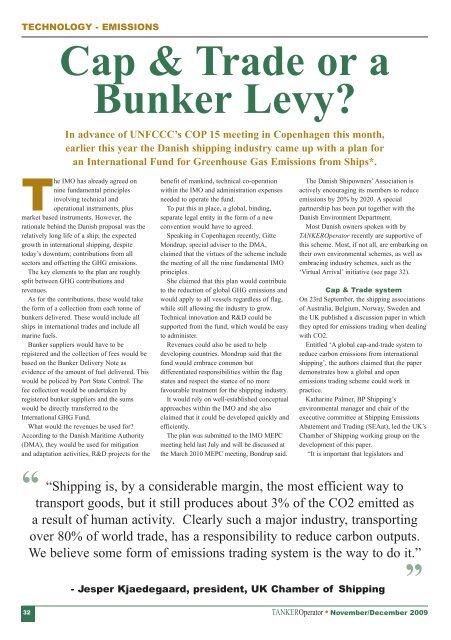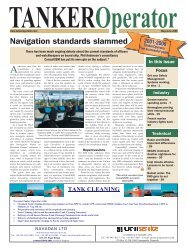Features: - Tanker Operator
Features: - Tanker Operator
Features: - Tanker Operator
Create successful ePaper yourself
Turn your PDF publications into a flip-book with our unique Google optimized e-Paper software.
TECHNOLOGY - EMISSIONS<br />
Cap & Trade or a<br />
Bunker Levy?<br />
In advance of UFCCC’s COP 15 meeting in Copenhagen this month,<br />
earlier this year the Danish shipping industry came up with a plan for<br />
an International Fund for Greenhouse Gas Emissions from Ships*.<br />
The IMO has already agreed on<br />
nine fundamental principles<br />
involving technical and<br />
operational instruments, plus<br />
market based instruments. However, the<br />
rationale behind the Danish proposal was the<br />
relatively long life of a ship; the expected<br />
growth in international shipping, despite<br />
today’s downturn; contributions from all<br />
sectors and offsetting the GHG emissions.<br />
The key elements to the plan are roughly<br />
split between GHG contributions and<br />
revenues.<br />
As for the contributions, these would take<br />
the form of a collection from each tonne of<br />
bunkers delivered. These would include all<br />
ships in international trades and include all<br />
marine fuels.<br />
Bunker suppliers would have to be<br />
registered and the collection of fees would be<br />
based on the Bunker Delivery Note as<br />
evidence of the amount of fuel delivered. This<br />
would be policed by Port State Control. The<br />
fee collection would be undertaken by<br />
registered bunker suppliers and the sums<br />
would be directly transferred to the<br />
International GHG Fund.<br />
What would the revenues be used for?<br />
According to the Danish Maritime Authority<br />
(DMA), they would be used for mitigation<br />
and adaptation activities, R&D projects for the<br />
benefit of mankind, technical co-operation<br />
within the IMO and administration expenses<br />
needed to operate the fund.<br />
To put this in place, a global, binding,<br />
separate legal entity in the form of a new<br />
convention would have to agreed.<br />
Speaking in Copenhagen recently, Gitte<br />
Mondrup, special adviser to the DMA,<br />
claimed that the virtues of the scheme include<br />
the meeting of all the nine fundamental IMO<br />
principles.<br />
She claimed that this plan would contribute<br />
to the reduction of global GHG emissions and<br />
would apply to all vessels regardless of flag,<br />
while still allowing the industry to grow.<br />
Technical innovation and R&D could be<br />
supported from the fund, which would be easy<br />
to administer.<br />
Revenues could also be used to help<br />
developing countries. Mondrup said that the<br />
fund would embrace common but<br />
differentiated responsibilities within the flag<br />
states and respect the stance of no more<br />
favourable treatment for the shipping industry.<br />
It would rely on well-established conceptual<br />
approaches within the IMO and she also<br />
claimed that it could be developed quickly and<br />
efficiently.<br />
The plan was submitted to the IMO MEPC<br />
meeting held last July and will be discussed at<br />
the March 2010 MEPC meeting, Bondrup said.<br />
The Danish Shipowners’ Association is<br />
actively encouraging its members to reduce<br />
emissions by 20% by 2020. A special<br />
partnership has been put together with the<br />
Danish Environment Department.<br />
Most Danish owners spoken with by<br />
TAKER<strong>Operator</strong> recently are supportive of<br />
this scheme. Most, if not all, are embarking on<br />
their own environmental schemes, as well as<br />
embracing industry schemes, such as the<br />
‘Virtual Arrival’ initiative (see page 32).<br />
Cap & Trade system<br />
On 23rd September, the shipping associations<br />
of Australia, Belgium, Norway, Sweden and<br />
the UK published a discussion paper in which<br />
they opted for emissions trading when dealing<br />
with CO2.<br />
Entitled ‘A global cap-and-trade system to<br />
reduce carbon emissions from international<br />
shipping’, the authors claimed that the paper<br />
demonstrates how a global and open<br />
emissions trading scheme could work in<br />
practice.<br />
Katharine Palmer, BP Shipping’s<br />
environmental manager and chair of the<br />
executive committee at Shipping Emissions<br />
Abatement and Trading (SEAat), led the UK’s<br />
Chamber of Shipping working group on the<br />
development of this paper.<br />
“It is important that legislators and<br />
“<br />
“Shipping is, by a considerable margin, the most efficient way to<br />
transport goods, but it still produces about 3% of the CO2 emitted as<br />
a result of human activity. Clearly such a major industry, transporting<br />
over 80% of world trade, has a responsibility to reduce carbon outputs.<br />
We believe some form of emissions trading system is the way to do it.”<br />
- Jesper Kjaedegaard, president, UK Chamber of Shipping<br />
”<br />
32<br />
TANKER<strong>Operator</strong> November/December 2009

















